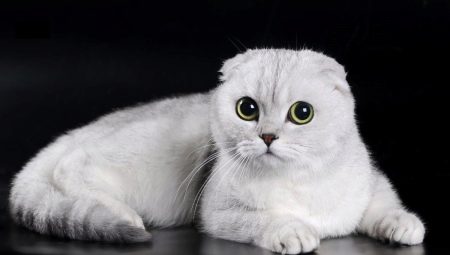A relatively young cat breed - Scottish fold (Scottish fold) - was very quickly able to gain love and popularity around the world, attracting more and more fans with its unusual appearance and various colors. A special place among them is occupied by infrequently encountered white Scottish folds. Not every potential owner of a white lop-eared kitten with blue eyes knows that this particular species of cute animals has its own peculiarities and nuances of keeping and caring.
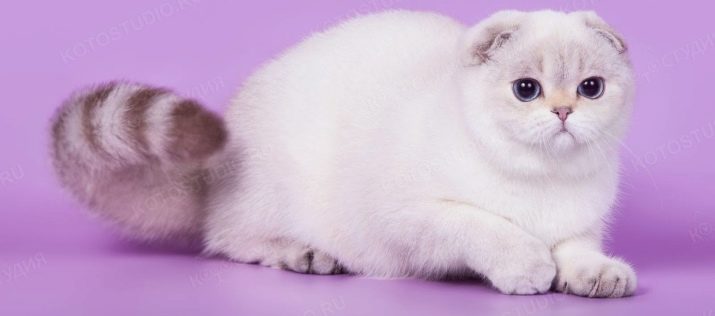
History
Scottish folds trace their history to classic British cats. The pioneer of the breed is a farmer from Scotland, William Rossi, who in 1961 noticed an unusual white kitten named Susie from his neighbor. The ears of the kitten did not stick up, like ordinary cats, but were bent forward and lowered down. William became very interested in unusual animals and after some time acquired his kitten, which inherited from his mother not only white color, but also the unusual shape of his ears.
William and his wife Mary crossed a white fold kitten with a British British cat. The result was the progenitor of modern Scottish folds. The breed was officially registered in 1965. But in 1971, it turned out that cats with an unusual appearance had health problems, since the mutated gene, responsible for the unique shape of the ears, endowed its owners with deafness and problems with the spine. The existence of the breed has been threatened.
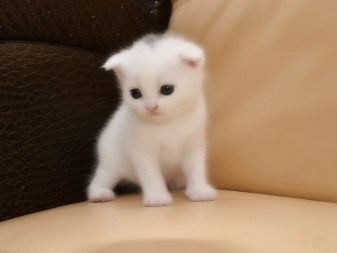
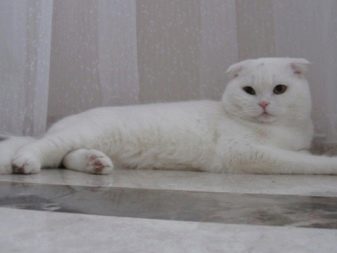
But by that time the Scottish folds had already gained a mass of admirers, and active work began to eliminate genetic problems. It was found that at the same time, both fold Scottish cats (Scottish folds) and straight-eared (Scottish Straights) can be born. As a result, a method that can significantly reduce the likelihood of a defective gene manifesting by crossing Scottish folds only with Scottish Straights, and not with fold brothers, was finally found. In this way, breed confirmed the right to exist.
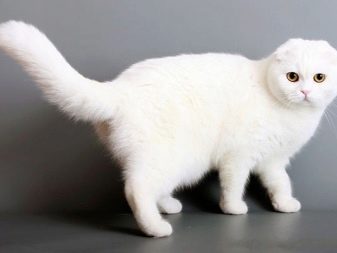
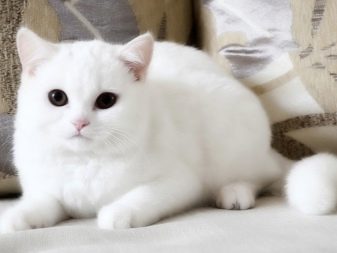
Characteristic
We can say that Scottish folds are an almost perfect pet option. Owners characterize Scots as the most livable and peaceful creatures in comparison with other cat breeds and note their following positive features:
- calm, peaceful character;
- moderately playful and inquisitive;
- tied to the owner, but not jealous;
- self-sufficient, not afraid of loneliness;
- They don’t like heights, therefore they don’t jump on furniture and do not spoil curtains;
- have a quiet voice, meow very rarely;
- smart, amenable to training;
- Sociable, suitable for families with children, as well as for older people;
- get along with most other pets;
- very clean;
- centenarians - with good care, live up to 20-22 years.
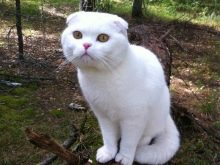
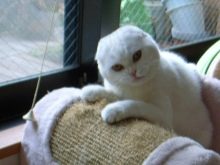
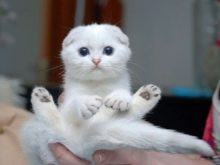
There is an interesting behavior feature that is characteristic of Scottish cats: they like to periodically stand on their hind legs and freeze in this position, like a gopher. This is due to the structural features of the spine, requiring such a kind of warm-up.
The disadvantages of the breed are mainly related to possible health problems. The weak points of Scottish folds are joints and eyes. Since the breed arose as a result of gene mutations, arthritis and arthrosis, disorders in the development of bones, can be inherited. Eye diseases - glaucoma and cataracts - are found in older cats, and eyelid twisting can occur due to the structure and shape of the eyes. In this case, surgery is required.
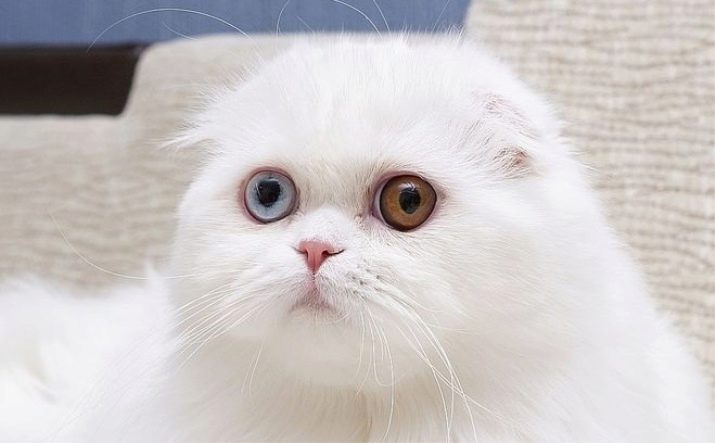
Description
The popularity of Scottish folds is largely due to their very attractive and unusual appearance, which must comply with the following standards:
- the maximum weight of a cat is 8-10 kg, cats - 4-5 kg;
- strong, stocky body with a wide chest;
- well-developed muscles, powerful legs and neck;
- flexible tail of medium length;
- spherical head;
- round, bright, widely spaced eyes of various shades;
- small, forward, folded in half ears;
- small nose, round cheeks, massive chin;
- short, thick, plush coat with a very thick and dense undercoat;
- extremely diverse colors (smoky, tortie, purple, black, cream and many others).
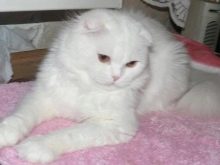
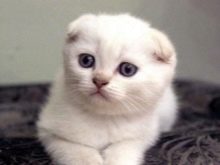
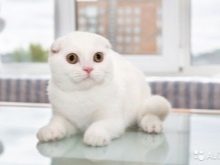
White Scottish Folds with Blue Eyes. It is a white cat that is considered the ancestor of Scottish fold. Among lovers of the breed, such a color is considered very popular and popular. White lop-eared kittens with blue eyes are especially appreciated, causing a feeling of tenderness and purity. Such animals are born extremely rarely, and their fans often have to sweat in search of their dreams.
It is almost impossible to guarantee the appearance of Scottish fold in the litter. All kittens are born erect, and only after 3-5 months the shape of the ears begins to take its final shape: it remains to stand or bend into a fold. Folding ears can be different: from single to triple. The larger it is, the more valuable and thoroughbred the cat is.
It is even more difficult to predict the appearance of a white fold kitten. Even with both snow-white parents, in connection with the presence of a huge variety of colors in the genetic set, kittens of the most varied colors may appear.
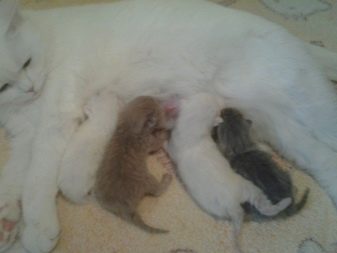
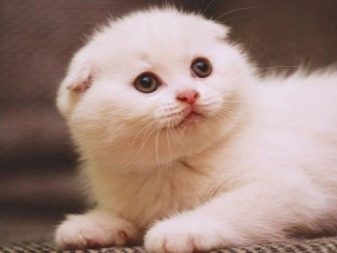
It happens that the color can appear only after a few generations, so it will not be superfluous to carefully study the pedigree of a potential pet.
The pigment melanocyte is responsible for the color of the eyes of the animal.For the birth of a white kitten with blue eyes, a combination of circumstances is necessary so that the pigment content in the iris is minimal. More often, pigment is present in sufficient quantities, so kittens are born with yellow, brownish or green eyes.
It should be noted that a gene that provides an animal with a rare white color, unfortunately, in 50% of cases gives its owner a defect - deafness. For this reason, when choosing a kitten, you need to check his hearing. True, problems with a hearing aid in such cats are compensated by an exacerbation of other senses. For example, a strong sensitivity to vibrations develops, due to which the animal reacts to the voice and recognizes movement. Often owners of hearing impaired cats are not even aware of the presence of such a defect, as animals have a very good reaction.
More frequent is the appearance of a white fold kitten with eyes of different colors, one of which is blue. In this case, deafness on the part of the ear is possible on the same side as the blue eye.

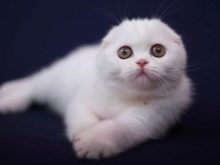

When a kitten with blue eyes is nevertheless found and well tested, you need to be prepared to pay a significant amount for it than for a Scottish fold of the usual color. The cat's exclusive appearance will cost 30-50% more than the standard price.
Care Features
If you still managed to become the proud owner of a snow-white blue-eyed miracle, you must provide your pet with comfortable living conditions.
The kitten house is best placed in a secluded place, protected from drafts, to which kittens are very sensitive. It is necessary to regularly examine the eyes and nose of the animal, as lacrimation can become a sign of a cold. The likelihood of bronchitis is also very high.
Scottish folds quickly become accustomed to the tray, while for white animals it is necessary to choose its height more to avoid contamination of the paws and abdomen.
Snow-white wool will require more frequent bathing (for other colors, bathing is necessary once every 2 months), while detergents should be soft and neutral, without tinting components and fragrances. After washing, wet hair should be gently patted with a towel and blow dry with a hairdryer to prevent dust from sticking.
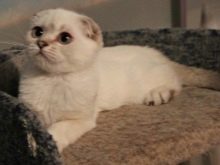
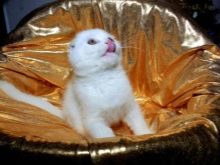
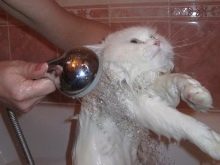
Also, Scottish fold should be combed regularly with a special brush of medium stiffness, but in no case against wool.
A kitten needs good nutrition, rich in vitamins and minerals, which may contain natural foods (low-fat meats, fish, boiled vegetables, cereals, sour-milk products) or premium fodder. If necessary, various dietary supplements can be included in the diet.
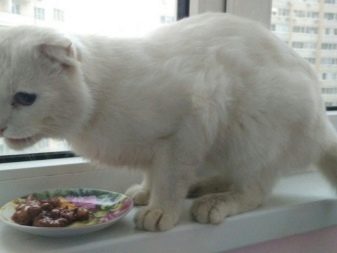
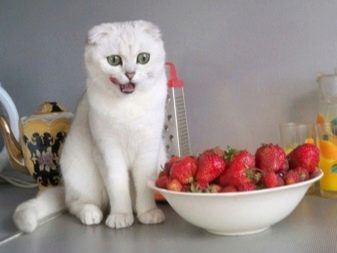
If a pet is hard of hearing, you should treat him with due attention on walks and not let one out on the street. No need to shout and raise your voice at the cat - he may be offended and begin to ignore the owner.
About the features of caring for cats of this breed, see the next video.
